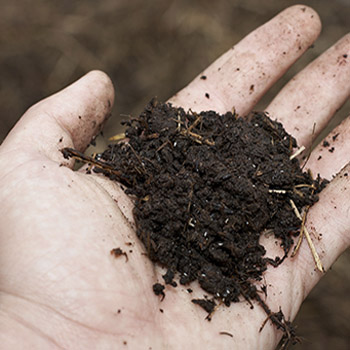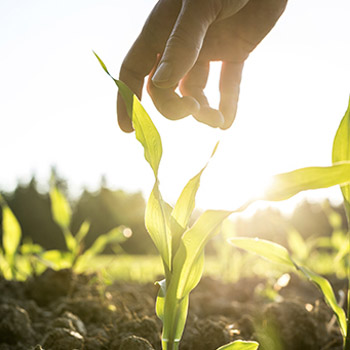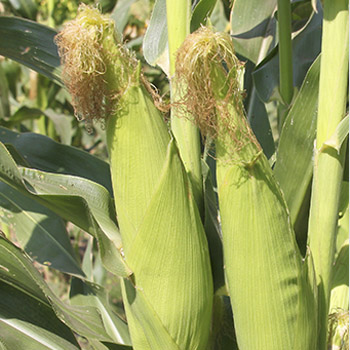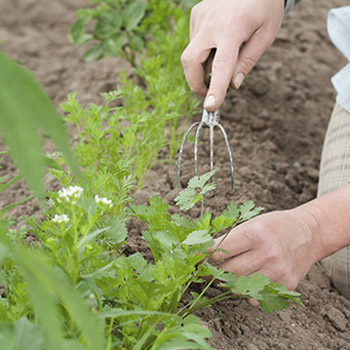Benefits of organic farming
Less up-front investment
An organic farm requires less capital investment than a conventional farm, since it does not require the purchase of chemical fertilizers. Many farmers take out large loans to get started, but organic farmers don’t rely on chemicals - this means taking less of a blow if the crop yield is low in a particular year.
Biodiversity and nutrition
The environment benefits from organic farming in many ways. Avoiding harsh chemicals allows for better biodiversity - in fact, organic farming thrives on diversity. This keeps the soil rich, which means good crops will continue to grow year after year. Your produce will also taste better and be more nutritious than conventionally grown crops, thanks to the richness of the soil.
Higher profit margins
Depending on the conditions, organic farming methods may yield less than conventional methods. However, the premiums are high with organic farming as most organic produce is sold for 20-30% more than conventional produce. So with less start-up debt and higher profits, an organic farm is able to be more successful in a short amount of time.
No harmful emissions
In addition to better biodiversity, organic farming helps protects the environment in other ways. Most notably, an organic farm won’t secrete chemicals into water sources, and its fertilizers don’t release toxic gases into the air. Since organically grown food is also most often purchased and eaten locally, it cuts down on transportation costs, fossil fuel usage, and harmful greenhouse gas emissions.
Methods of Organic Farming

Organic Fertilizer
Making fertilizer is one of the most important aspects of farming organically. This process includes using the optimal nutrients to enhance the growth of your crops. Organic farming methods like composting, mulching, and using bio-fertilizers will help promote healthy crop growth, as well as soil richness. Vermicomposting is another excellent method of introducing important nutrients into the soil naturally. The Organic Agriculture Centre of Canada provides an extensive guide where you can find more information about how you can get started with Vermicomposting.
Optimal Timing & Temperatures for Crop Growth
Prepping the soil for planting is key. Depending on the intended crop, soil prep should take place at certain times before planting. When growing organic corn, work aged animal manure or organic compost into the soil, then plot with plastic sheets for a few weeks to ensure the nutrients remain, making sure the temperature of the soil at planting time is above 12°C (55℉). Generally you will want to plant corn seeds two weeks after the last spring frost date. For more information about ideal planting temperatures for different crops, refer to the resource table here.

Hardy Vegetables
Broccoli, Cabbage, Kohlrabi, Onions, Lettuce, Peas, Radish, Spinach, & Turnips
Temperature
- Dry Soil
- Plant 2-4 weeks before the date of avg. last spring frost.
- Can survive temperatures as low as 4°C/40°F
Semi-Hardy Vegetables
Beets, Carrots, Cauliflower, Parsley, Parsnips, Potatoes, & Swiss chard
Temperature
- Dry Soil
- Plant 2-4 weeks before the date of avg. last spring frost.
- Min. Daytime Temperatures of 4°C/40°F to 10°C/50°F.
- Sensitive to frost
Tender Vegetables
Beans, Celery, Corn, Cucumbers, Summer Squash, NZ Spinach
Temperature
- Dry Soil
- Plant around the date of avg. last spring frost.
- Daytime Temperatures above 12°C/55°F.
Very Tender Vegetables
Beans, Celery, Corn, Cucumbers, Summer Squash, NZ Spinach
Temperature
- Dry Soil
- Plant around the date of avg. last spring frost.
- Daytime Temperatures above 12°C/55°F.
Source: Colorado State University
Crop Rotation
Organic farming relies on good, natural soil health so crop rotation is a big part of the process. Rotating crops in your field keeps the soil balanced so certain nutrients don’t get depleted, since various crops require different nutrients and leave other ones behind. Crop rotation is important to reduce pressure from insects, weeds, while supplementing nutrients in the soil. These trap crops that are planted between the main crop will also keep the soil rich and help avoid erosion. For more information on crop rotation, visit The Ontario Ministry of Agriculture, Food & Rural Affairs.


Weed Management
For farmers, weed management can be a stumbling block to producing organic corn and other crops. Weeds can reduce your yields and consume resources intended for your crops, including nutrients, water, and sunlight. There are many options that organic farmers can use to control weeds including manual weeding (hand removal, pulling, and cutting), mowing, mechanical cultivation, and thermal control (flaming). For corn, mechanical weed control is the best method.
Mechanical Weed Control includes using preplant tillage such as plowing, disking, and field cultivating to significantly minimize the spread of specific perennial weeds and get rid of emerged weed seedlings.
Manual Weeding is effective at stopping the growth of small weeds but be careful when removing as you want to make sure you don’t lose any corn seeds in the process.
Crop Rotation can also be an incredibly effective way at reducing weed pressure and is a good method for long-term weed control.
Thermal Control is a method that uses a propane, butane or gas powered flame thrower to rid the soil of pesky weeds. Flaming was a popular method used in the 1940s-1950s before the invention of synthetic pesticides and is gaining popularity again. Flaming is ideal for crops that are spaced out in wide rows.
Here are 12 tips for growing organic corn on your farm!
1. Start with a plan
Just like any endeavour, the smart way to start is by planning. Success doesn’t happen by accident, so come up with a business plan that takes into account your financial situation, your ideal crops, how much you plan to invest and hope to yield, and what kinds of equipment to buy.
2. Consult other organic farmers
In the planning stages of your process, talk to other people who are already farming organically. Find out what works for them. Ask them what they wish they had known in their beginning stages. You can also find helpful resources online including webinars, workshops, and certification programs for farmers across Ontario. The Canadian Organic Growers provides a number of these educations resources at http://www.cog.ca/
3. Know the correct time to plant
Seeds respond to certain soil temperatures, so planting too soon can be wasteful. Corn seeds require that the soil be at least 12°C (55℉) in order to start sprouting. Any cooler, and they may take weeks to sprout, or worse, not sprout at all. Different vegetables will have different temperature tolerances, so make sure you research ideal planting times for the crops you choose.
4. Wait until the soil temp is optimal for germination
Corn is a warm-season crop. While it can survive at a minimum of 10°C (50℉), it is recommended that you wait until there are consistent warm temperatures in your region. Preferred soil temperature for corn seed germination ranges from 16°C-35°C (60.8℉ – 95℉). With this in mind, it’s important be patient and ensure that you are not planting too early.
5. Increasing nutrients in the soils through cover crops, manure, etc
Methods like adding manure and additional plants can provide benefits to your crops by adding extra nutrients and stabilizing the soil. Cover crops help prevent soil erosion, increase water infiltration, recycle nutrients, fight against insects, and prevent the growth of weeds through soil competition. Since cover crops also protect the soil from the impact of rain and wind, erosion will decrease and cause nutrient efficiency to rise.
6. Consider the climate
Where you live will have an impact on which plants will thrive on your farm, when you plant, and when to harvest. Your decision of what to plant will also be influenced by what’s going to provide the best economic returns, and will be in demand for sale. Again, consulting local farmers will help, as well as researching which types of crops thrive using organic methods in your geographic region. For a summary of different growing regions in Canada, visit http://www.thecanadianencyclopedia.ca/en/article/crops/.
7. Consider other eco-friendly options, too
Try incorporating other environmentally friendly – and economically friendly – alternatives into your organic farm, such as harnessing solar energy. Using sustainable resources is a great way to further your organic endeavours. Sharing equipment with other local farmers can also be beneficial, especially if you’re new to the lifestyle and starting small. By splitting the costs and sharing the tools with your neighbours, you will cut down on investment costs and enjoy higher profit margins.
8. Transition slowly
If you’re transitioning from a non-organic farm, transition slowly, as your soil may also be feeling the difference from no longer using chemical fertilizers. It will take some time to bounce back, so use methods such as planting trap crops and companion crops to keep your soil in good shape between main crops. You can find more information about these methods here.
9. Introduce friendly insects
Depending on which plants you’re growing, there are insects that will help them thrive, and will protect your plants from other harmful insects. It’s all part of a balanced ecosystem. For example, Ladybugs are incredibly important when it comes to protecting your farm from aphids, mites, mealybugs and other pests. For a larger list of good insects and how to attract them to your farm, you can check out this article by the Modern Farmer.
10. Know the certification requirements
Being certified as an organic farm comes with certain requirements. Research what those things are, and be sure you can prove that you’re doing everything right in order to get that certification. Check your local government website to find out what these stipulations include. Ontarians can find the proper information on certifications for organic farming by visiting the Ontario Agriculture, Food, and Rural Affairs website. For Canadians outside of Ontario, visit the Canadian Food & Inspection Agency to see how you can become a certified Organic Farmer.
11. Harvest right
One of the many benefits of organic farming is the financial reward of high output value. Harvesting at the right time is as crucial to getting the best results, and optimal harvesting times will vary depending on the types of crops you are growing. For detailed information about when the proper times to harvest specific crops are, visit this helpful resource.
12. Rotate your crops
After you’ve harvested your crops, leave the soil in the best condition possible for starting the next season’s planting. Rotate in another crop of your choice to balance the soil’s composition before planting your main crop again next season. This will help create diversity in crop residues in the soil, which in turn provides a wide variety of beneficial soil organisms. Learn more information and the benefits of crop rotation from The Ontario Ministry of Agriculture, Food & Rural Affairs.
Starting an organic farm is a great way to increase your yields and profits while living a more sustainable and environmentally-friendly life. Lower input costs, stability, and higher output value will make organic farming ideal not only for your farm but your local economy as well. You’ll know exactly where your food comes from and how it was grown, all while enjoying the economic and environmental benefits to your farm as you start a cleaner, greener way of growing. By following these 12 organic farming tips, you’re equipped to starting planning the transition to growing organic crops today!
Sources
http://www.helpguide.org/articles/healthy-eating/organic-foods.htm
http://www.ext.colostate.edu/mg/gardennotes/720.html
http://extension.psu.edu/pests/weeds/organic/weed-management-in-organic-cropping-systems
http://www1.agric.gov.ab.ca/$department/deptdocs.nsf/all/agdex1203
http://www.mccc.msu.edu/states/Ohio/OH_CoverCrops_to_Improve_Soi&Water_Quality.pdf
